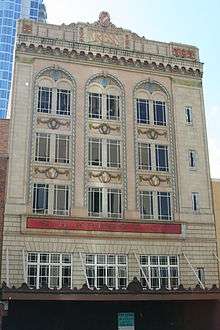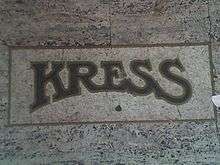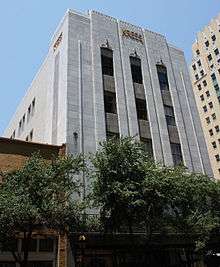S. H. Kress & Co.


S. H. Kress & Co. was the trading name of a chain of "five and dime" retail department stores in the United States, established by Samuel Henry Kress, which operated from 1896 to 1981. In the first half of the 20th century, there were Kress stores with ornamented architecture on "Main Street" in hundreds of cities and towns.
History
Kress opened his first "stationery and notions" store in Nanticoke, Pennsylvania in 1887. The chain of S. H. Kress & Co. 5-10-25 Cent Stores was established in 1896.[1] In the 1920s and 1930s, Kress sold a house label of phonograph records under the Romeo trademark. He died in 1955.
The company's exclusion of African Americans from its lunch counters made Kress a target for civil rights protests during the 1960 lunch counter sit-ins, along with Woolworth's, Rexall and other national chains.[2] In Nashville, Tennessee, Kress repeatedly refused to serve the protesters but eventually agreed to integrate the downtown store in exchange for ending a consumer boycott. The Greensboro, North Carolina Kress was included in the first civil rights demonstrations in the South.[3] In Adickes v. S.H. Kress Co., the U.S. Supreme Court threw out trespass convictions resulting from a sit-in at a Kress lunch counter in Mississippi. The Kress store in Baton Rouge was the site of that city's first civil rights sit-in. That event helped save it from demolition 45 years later.[4]
In 1964 Genesco, Inc. acquired Kress. The company abandoned its center-city stores and moved to shopping malls. Genesco began liquidating Kress and closing down the Kress stores in 1980. The remaining Kress stores were sold to McCrory Stores on January 1, 1981. Most continued to operate under the Kress name until McCrory Stores went out of business in 2001.
Tiendas Kress, the subsidiary chain in Puerto Rico, survived the parent company and is still in business there. The Kress Foundation, a philanthropic organization promoting art, was established by Kress in 1929 and also survives the parent company.

Architecture

The Kress chain was known for the architecture of its buildings.[5] "Samuel H. Kress... envisioned his stores as works of public art that would contribute to the cityscape."[6] A number of former Kress stores are recognized as architectural landmarks and many are listed on the National Register of Historic Places, including the 1913 building on Canal Street in New Orleans (now the New Orleans Ritz-Carlton) and the 1929 neoclassical store in Asheville, North Carolina.[7]
Notable Kress architects include Seymour Burrell, who studied in New York with architect Emmanuel Louis Masqueray, and Edward Sibbert,[7] who designed more than fifty Art Deco S. H. Kress & Co. stores between 1929 and 1944.
Sibbert's buildings streamlined the Kress image with a sleek buff modernity, the lavish use of terracotta ornament, and strong verticals supporting the golden letters “Kress”. Curved glass display windows led the shopper through heavy bronze doors into an interior of rich marbles, fine woods, and large customized counters set crosswise down a long sales floor. Well-positioned hanging lamps created a bright atmosphere for an endless array of inexpensive items (there were 4,275 different articles on sale in 1934). Everything – from the constantly restocked merchandise to the gracious retiring rooms and popular soda fountain in the basement – encouraged customers to linger. Like the great movie houses of the day, the dime store – and ‘Kress’s’ in particular – was a popular destination during hard economic times.[8]

Sibbert's Mayan Revival Kress store on Fifth Avenue in New York City was built in 1935 and demolished in 1980.
A seven-story marble structure designed for every shopping comfort, its Art Deco elegance was graced by airborne Mayan gods on the sales floor and Mayan-style hieroglyphs of the gloves and padlocks and yard goods for sale. Awarded a gold medal for architectural quality, the store represented the zenith of the Kress empire in luxury, modernity, and retailing capacity.[8]
The downtown Kress store in Greensboro, North Carolina is a characteristic example that shows the chain's use of elaborate exterior details including coats-of-arms, metal work, and inlaid artistic flourishes on the keystones and corners.
The National Building Museum in Washington, D.C. holds a permanent collection of Kress building "records, including thousands of drawings and photographs relating to the design, construction, and operation of more than 200 stores stretching from New York to Hawaii."[6]

Reuse of Kress buildings
Kress buildings around the country have been adapted for reuse.
- Asheville, NC: The Kress building on Patton Avenue in Downtown Asheville was restored in the 1990s, and is now The Kress Emporium - a gallery featuring local artists, K2 Studio - a home and furniture store, as well as condominiums in the upper floors.
- Baton Rouge, LA: The Kress building was scheduled to be demolished but was spared in 2005, and has been renovated for residential use.
- Biloxi, MS: The downtown Kress store was converted in 2014 into a live music venue, Kress Live.
- Meridian, MS: The downtown Kress building is undergoing renovation and is slated to open in early 2016 as the new home of the Mississippi State University Meridian campus Kinesiology program.
- Columbia, SC: The Kress building has been renovated into apartments with first floor restaurant and office space.
- Charleston, SC Kress store on King Street is now an H&M store
- Daytona Beach, FL: The Kress Building located on Beach Street downtown is restored with each floor having a different retro theme and is now home to many small businesses as well as a business center and shared office facility called Work Webb.
- Fort Worth, TX: The 1936 Kress building in downtown Fort Worth leases residential and office space.
- Florence, SC: The former Kress building is now a part of the Downtown Florence Revitalization Project. This building will house a new restaurant, named Town Hall, a rooftop bar, retail spaces, small condos, and office space. Many of the materials used in building these spaces came from the original building. The majority of the wood used in the project was reclaimed from original infrastructure and Kress store shelves - keeping the appearance as historically accurate as possible.
- Greensboro, NC: The former Kress building now houses TAVO Restaurant & Tavern, an office area along with a nightclub on the basement level and an entertainment area on the roof.
- Greeley, CO Kress store on 8th Avenue and 9th Street is now an independent movie theater (since 2008). www.kresscinema.com
- Hilo, HI: In Hilo, Hawaii, a former Kress store has been renovated into Kress Cinema, a downtown movie theater.
- Key West, FL: The Kress Building, located at 500 Duval Street, was home to the eccentric department store Fast Buck Freddie's from 1977 until 2013. The interior is now being renovated into a CVS drugstore.
- Los Angeles, CA: In July 2008, The Kress Hollywood nightclub and restaurant opened for a few years in the Kress building on Hollywood Boulevard. This former Kress store, built in 1934, served as the flagship Frederick's of Hollywood boutique for 59 years.
- Memphis, TN: The fourth Kress store built on Main Street is now the conference center for the adjoining SpringHill Suites hotel.
- Nashville, TN: The Kress store on 5th Avenue in downtown Nashville is now two loft complexes called Art Avenue Lofts and Kress Lofts.
- Orlando, FL: The Kres Chophouse restaurant occupies the downtown Orlando building.[9]
- Seattle, WA: In June 2008, an IGA Supermarket, the Kress IGA, opened on the basement level of the former Kress store in downtown Seattle.
- Wichita, KS: The Kress building is now called the Kress Energy Center. This Kress Building is considered the best example of neo-gothic commercial architecture in Wichita. It is listed on city, state, and national registers of historic places.
- Yuma, AZ: In March 2010, The Kress Ultra Lounge nightclub and Da Boyz Italian Cuisine opened in the Kress building in downtown Yuma on Main Street.
The Kress IGA Supermarket, Kress Hollywood, and Kress Cinema differ from many other re-purposed Kress locations due to their prominent use of the Kress name and logo as a component of the branding of the business.
See also
- List of S. H. Kress and Co. buildings
- Kress Building
- S. H. Kress and Co. Building (Daytona Beach, Florida)
- Kress Building (Fort Worth, Texas)
- Kress Building (Gastonia, North Carolina)
References
- ↑ The Kress Legacy. The Kress Foundation
- ↑ Nashville Student Movement (1960-1964). Civil Rights Movement Veterans
- ↑ First Southern Sit-in, Greensboro NC. Civil Rights Movement Veterans
- ↑ "Salvation Stories." 225BatonRouge.com
- ↑ "Kress Buildings Across Texas & America" Texas Escapes. Retrieved 2016-07-10.
- 1 2 S. H. Kress & Company Collection. National Building Museum
- 1 2 Thomas, Bernice L. (1997). America's 5 & 10 Cent Stores: The Kress Legacy. New York: John Wiley & Sons, Inc. ISBN 0-471-18195-1
- 1 2 S. H. Kress & Co. Stores. The Kress Foundation
- ↑ http://www.kresrestaurant.com/location
External links
| Wikimedia Commons has media related to S. H. Kress & Co.. |
- The evolution of a downtown corner.
- Berkeley's Landmarks
- Greensboro, North Carolina Kress store history
- The S.H. Kress & Company Collection at the National Building Museum